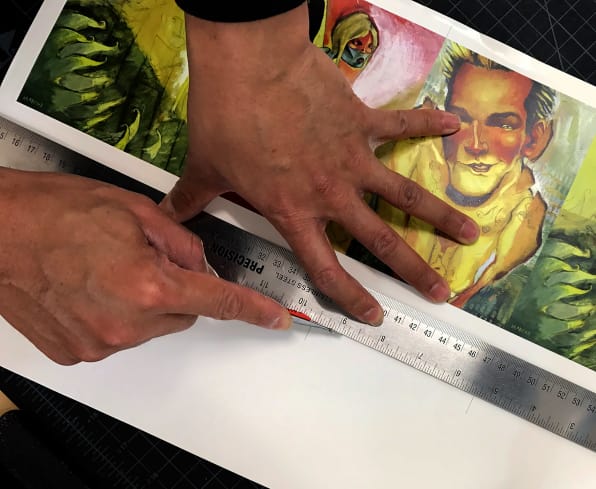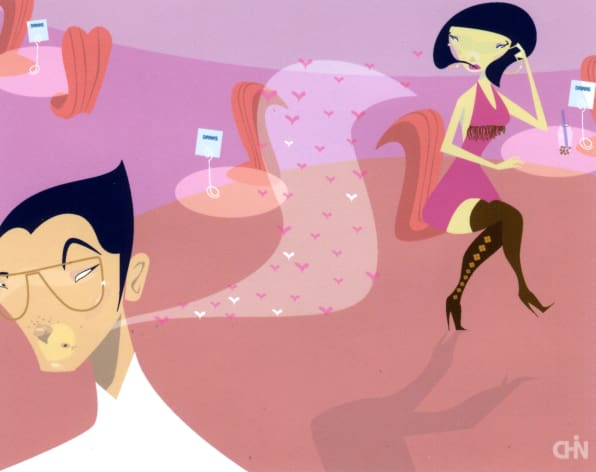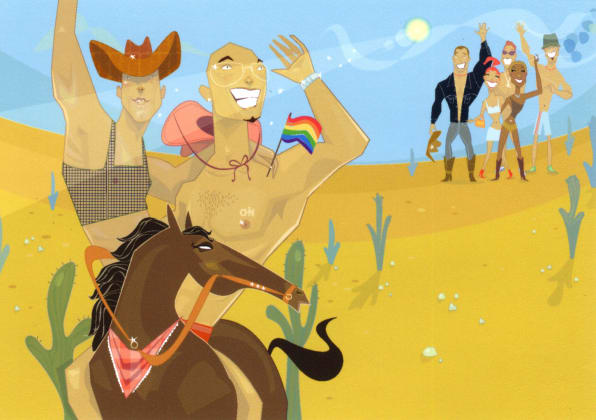It’s June 1999, and I’m living in Toronto. A guy I know from art school comes into the store today, and he’s surprised to see me. “I thought you’d be doing something else?” he asks. I laugh nervously.
At graduation, weeks before, I’d won a big scholarship, the one that’s given to just a single student in each department. When I walked up to receive it, the MC read aloud a short blurb I’d written–something self-deprecating about how after graduation I expected to be living at home with my parents, working in retail, and trying my best to become a freelance illustrator.
Self-deprecating, but as it turns out, entirely accurate.
The other students who’d received awards sounded like they had way more potential: So-and-so would be working at this design firm, and that other person would be at such-and-such ad agency. In art college, I used to call freelance illustration the “dying profession,” and now here I was, struggling to break into it.
What would it even look like once I did? If I did?
It would be another two and a half years before I’d be able to answer that–before I could finally quit my job at the Gap, move out of my parents’ house, and begin happily earning a living in the dying profession (and I’m even happier to say, I still am). Here’s what it took for me to get there, from graduation day to going full-time.
August 1999
I’m pounding pavement like crazy looking for work. Thankfully, I connected with a couple teachers in art school who run design firms, publish trade magazines, and hire young talent. I don’t know what I’d have done without them. Illustrating one full page can get you about $750, and a cover pays even more.
Meanwhile, I’m poring over magazines at St. Mark’s Bookshop, on Queen and John Streets, trying to build my own mailing list of art directors to pitch to. (The cost of buying one is around $1,000–way out of budget.) I show up every few days and page through as many as I can, quickly scanning mastheads and jotting down names and addresses, because I don’t want to outstay my welcome; I’m not buying anything.
When I get home, I try to decide which art directors to mail my postcard promotions to. It’s crazy how many names I’ve compiled already–over 100! It’s my dream to work with Gail Anderson at Rolling Stone.
October 1999
My first promo is nearly done. My dad is helping me put it together. It’s a small cardboard box containing a handmade book with a few illustrations. The theme is “My Wishes,” one of which is to be Brad Pitt (duh), and another is to have tea with Oprah–I painted portraits of them both. I’ve also bought some decorative raffia to put into the box and nestled some dime bags filled with glittery sand (à la “Mr. Sandman,” the 1950s hit by the Chordettes), then sprinkled everything with foil stars–you know, to reinforce the theme.

Anyway, I’ve put a lot of work into this–and money, too. I had no idea how expensive it is to mail 300 boxes! But gotta spend money to make money, right? I’m excited!
November 1999
I can’t believe no art directors responded to my promo–the boxes were so cute! What a waste! Next time I’m just using the school’s computer lab and printer (alumni privileges), then mailing those out instead. It’ll be much cheaper.
January 2000
Lately I’ve been playing around making new portfolios. In school we were told to present our work in black presentation cases, but I want mine to stand out, so I’ve made a hand-bound book that’s white instead. When I show art directors my portfolio, I want them to remember me as the guy with the white book!
June 2000
The white book didn’t work. Fortunately I’ve cobbled together a few illustration gigs that pay around $400–$500 a month. I’ve been fretting over money because I’m anxious to move out of my parents’ house. But by now the cash I’m making from those freelance gigs, added to my retail job, is just enough to cover rent–so I think I’m going to do it: I’m moving out!
April 2001
Money is super tight. The extra income I’d hoped would come from freelancing just isn’t reliable. I’ve been sending out promos, cold calling, and trying to meet with art directors in Toronto, but most of them aren’t returning my calls.
In the meantime, my friends who work in advertising have hired me to do storyboards. The money from those is awesome–one ad job is worth twice my rent–but there aren’t enough of those projects consistently.
June 2001
I’m on my lunch break at the Gap. I recently sent out a batch of postcards to some clients and a few illustration agents hoping that someone would call. Just checked my voicemail a second ago–nothing. I start to cry.
July 2001
I need a computer. I can’t afford to buy one, but my friend told me where I could lease one month-to-month. I tallied up the cost, and I can just barely afford it. I’m working enough hours at the Gap, and I’ve been lucky so far because I’m averaging two to three illustration assignments a month to help get me by.

October 2001
With my leased computer, I’ve been playing around with Adobe Illustrator these past few months. It’s pretty cool using the mouse to draw with. I’m not doing anything major, just drawing scenes of people hanging out and socializing. But I’m learning something and it’s pretty fun.
November 2001
It’s nighttime and I’m sweeping up the stockroom with the radio playing. Whitney Houston’s “One Moment in Time” comes on: Am I more than I thought I could be? It hits me that I’ve got to step it up and really push to get more illustration work. My new goal is to get out of this place by February.
December 2001
An illustration agent just called me! She said the paintings I sent her a few weeks ago weren’t cohesive enough, so I sent her a few of the drawings I made on my computer instead. She loved them and wants to give me a chance! I’m so happy!
February 2002
It took a while, but in the past few months it feels like I’ve finally got the momentum I’ve been looking for over the past two years. This is the most illustration work I’ve ever had at once–I can barely keep up. I’m still working at the Gap but doubt that I’ll be able to stay for much longer. In fact, I’m committing right now: I’m giving my notice in three weeks, no matter what. Time to do this full-time.
Oh, and some more good news: I got a call from Rolling Stone!

Marcos Chin is an award-winning illustrator whose work has appeared as surface and wall designs, on book and CD covers, and in advertisements, fashion catalogues, and magazines. He has worked with MTA Arts for Transit, Neiman Marcus, Fiat, Budweiser, Time, Rolling Stone, Fast Company, the New Yorker, GQ, Sports Illustrated, and the New York Times, among others.
Fast Company , Read Full Story
(22)